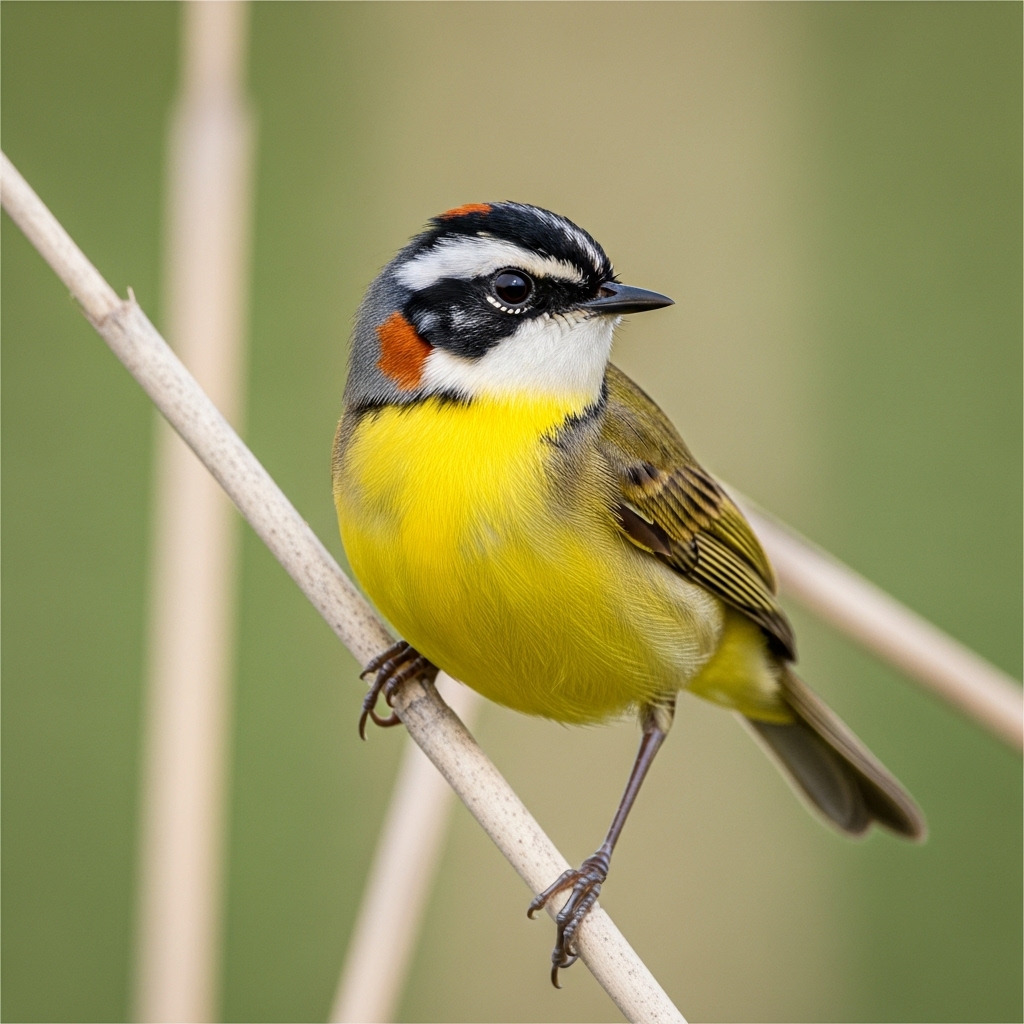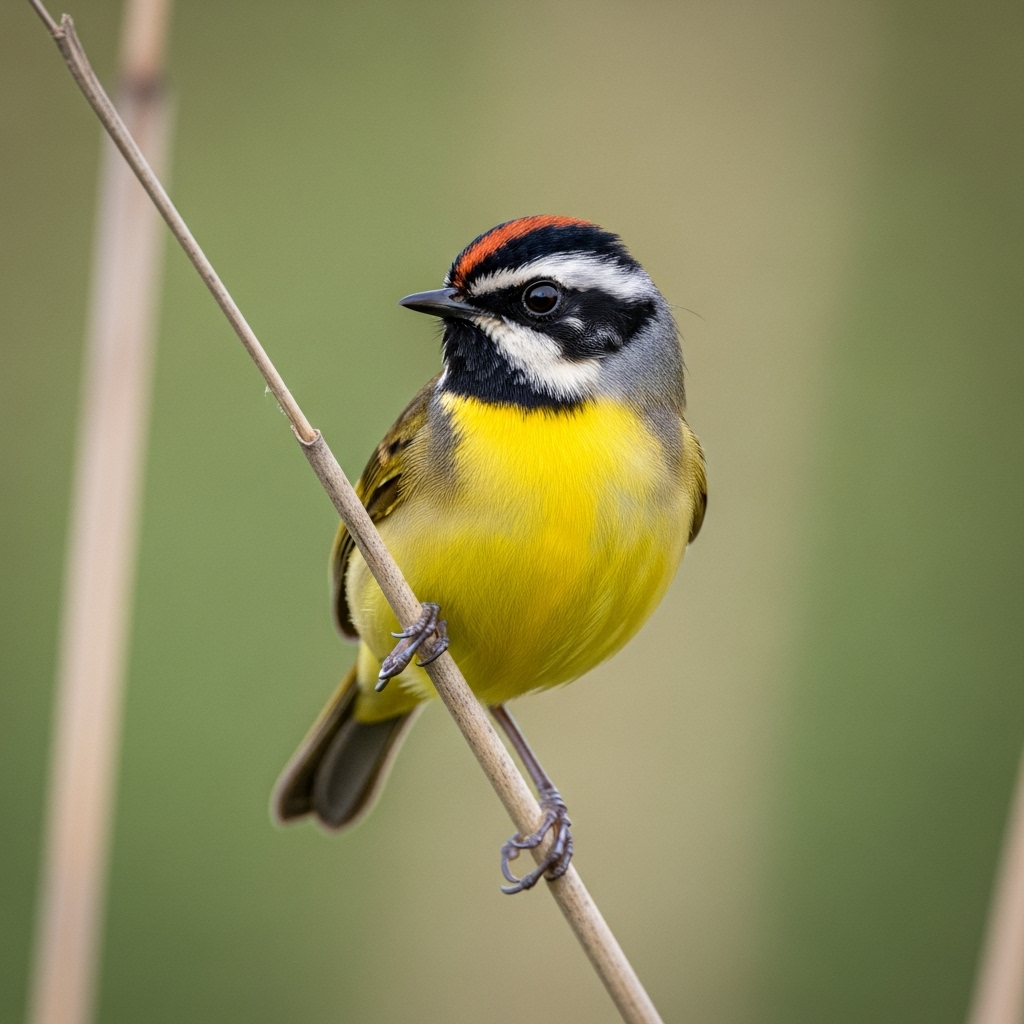Imagine a bird so small it could almost fit in a matchbox, yet so vibrant it looks like a painter’s palette that sprouted wings. This isn’t a fantasy. This is the Many-colored Rush Tyrant (Tachuris rubrigastra), a bird that lives up to its name in every conceivable way.
Tucked away in the dense reed beds of South America, this tiny marvel is a true “color explosion.” It’s a bucket-list sighting for birdwatchers and a stunning surprise for any nature lover lucky enough to spot one. But what makes this bird so special? Let’s dive into the world of this tiny feathered jewel.
A Rainbow in the Reeds: What “Many-Colored” Really Means
The name “Many-colored Rush Tyrant” is almost an understatement. In Spanish, it’s often called “siete colores” (seven colors), but even that feels conservative. This bird is a dazzling patchwork of brilliant, distinct colors.
Let’s break down the artistry:
- Head: The face is a striking blue-gray, set off by a bright yellow stripe (supercilium) above the eye and a jet-black cap. Hidden in that black cap is a fiery red crest, which it can flash during displays.
- Back: A bright, grassy olive-green that helps it blend into the reeds.
- Chest and Belly: The real showstopper. A brilliant, lemon-yellow chest is dramatically split by a black “V” or band.
- Wings: A complex pattern of black, white, and rufous (reddish-brown).
- Undertail: The color party continues all the way to the end with a rich, cinnamon-red patch under the tail.
This combination of yellow, blue, green, red, black, and white on a bird barely 4 inches long (10-11 cm) makes it one of the most spectacularly colorful birds in the world.

The “Rush Tyrant”: A Master of the Marsh
The “Many-colored” part is obvious, but what about the “Rush Tyrant”?
- “Tyrant”: This part of its name indicates it belongs to the Tyrant Flycatcher family—one of the largest and most diverse bird families in the Americas. Like its relatives, it’s an insectivore, darting out to snatch small insects from the air or from the reed stalks.
- “Rush”: This is the key to its entire life. This bird is an extreme specialist. It lives almost its entire life inside dense, tangled reed beds and rushes (like bulrushes or totora reeds) found in freshwater marshes, lakesides, and riverbanks.
You won’t see this bird soaring in the sky or hopping on a lawn. It’s a tiny, hyperactive creature that flits, climbs, and clings to vertical reed stems, behaving more like a mouse or a tiny monkey than a typical bird. This reliance on its reedy home is total: it builds its cone-shaped nest woven between reed stalks, it hunts in the reeds, and it hides from predators within the dense forest of stems.
Where to See South America’s Tiny Color Explosion
Despite its bright colors, the Many-colored Rush Tyrant can be surprisingly difficult to see. It’s a classic “skulker,” preferring to stay hidden deep within the reeds. But for the patient observer, the reward is unmatched.
You can find this bird in suitable wetland habitats across much of southern and western South America, including:
- Chile (where “siete colores” is the beloved national bird)
- Argentina
- Peru
- Bolivia (especially around Lake Titicaca, in the totora reeds)
- Southern Brazil
- Uruguay
- Paraguay
Tips for Spotting One:
- Go to the Reeds: Don’t waste time looking anywhere else. Find a dense, healthy freshwater marsh.
- Listen: Often, you’ll hear its sharp, insect-like “zzt” call before you see it.
- Be Patient: Stand quietly by the edge of the reeds and watch for movement. They are restless and rarely stay still, so you’ll likely see a flash of yellow or green darting between stems.
- Use Binoculars: This is a must. A quick flash of color will resolve into a stunning, multi-colored bird when you get your binoculars on it.
Quick Facts: The “Siete Colores”
- Scientific Name: Tachuris rubrigastra
- Size: 4 to 4.5 inches (10-11 cm)
- Weight: Weighs as much as two nickels (around 0.25 ounces or 7-8 grams).
- Habitat: Freshwater marshes and reed beds.
- Diet: Small insects.
- Key Feature: Incredibly vibrant, multi-colored plumage.
A Tiny Treasure Worth the Search
The Many-colored Rush Tyrant is a perfect example of nature’s artistry. It’s a bird that proves you don’t have to be big to be bold. This tiny color explosion is a testament to the wild, vibrant beauty hidden in plain sight, a feathered jewel waiting to be discovered in the rustling heart of a South American marsh.
Have you been lucky enough to see the “siete colores”? Or is this tiny gem now on your birding bucket list? Let us know in the comments!



